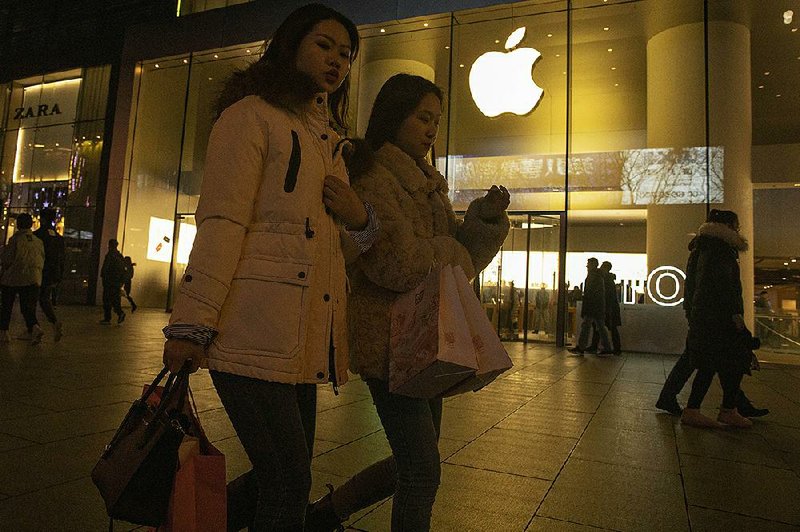WASHINGTON -- The Trump administration has dropped its plan to impose new tariffs on $160 billion of Chinese imports beginning Sunday under an interim deal that de-escalates a 17-month trade war between the world's two biggest economies.
President Donald Trump said that a 25% tariff that the United States had placed on $250 billion of Chinese products would remain in effect, but that a 15% tariff he put on $120 billion of products in September would be cut in half, to 7.5%.
A round of tariffs scheduled for Sunday that would have hit about $160 billion in Chinese goods would be canceled, he said, and talks for a second phase of the trade deal would begin immediately.
The scheduled Sunday tariffs would have extended the levies to just about everything China sells the United States and would have hit consumer items such as toys and smartphones that have so far largely been spared.
Beijing has retaliated by taxing $120 billion in U.S. exports, including soybeans and other farm products that are vital to many of Trump's supporters in rural America.
In the next two years, Beijing is committed to buying an extra $200 billion in U.S. agricultural, energy and manufactured goods, U.S. Trade Representative Robert Lighthizer said, including $32 billion from American farmers. The agreement contains specific figures for individual products such as poultry and animal feed, but they are not being made public to avoid disrupting commodity markets, he added.
[Video not showing up above? Click here to watch » https://www.youtube.com/watch?v=xKnmwQiVjJI]
Beijing also has committed to ending a long-standing practice of pressuring companies to hand over their technology as a condition of gaining access to the Chinese market.
Lighthizer said China also had agreed to lift nontariff barriers to the Chinese market for such products as beef, poultry, seafood, pet food and animal feed.
In all, the U.S. expects a $200 billion boost in exports over two years as a result of the deal.
"We expect the trade deficit to go down for sure," Lighthizer said, adding that the deal likely will be signed the first week in January and take effect 30 days later.
"Everything is written," he said. "Everything is completely finished."
The so-called phase-one agreement leaves some major issues unresolved, notably U.S. complaints that China unfairly subsidizes its own companies to give them an edge in world markets.
The deal does, however, at least temporarily defuse a conflict that has unnerved financial markets and hobbled global economic growth.
"This deal should go a long way in reversing the downward spiral in bilateral trade relations and increasing certainty for U.S. businesses," said Wendy Cutler, a former U.S. trade negotiator who is now vice president at the Asia Society Policy Institute.
But, Cutler cautioned, "it's unclear on how far the phase-one agreement goes in addressing the key structural issues that brought the U.S. to the negotiating table 17 months ago."
Trump, who first announced the agreement on Twitter, said that work on a follow-up agreement would begin immediately.
That announcement came minutes after the House Judiciary Committee approved impeachment charges of abuse of power and obstruction of Congress, leading the White House to argue that the president "never stops working and continues to make successful deals that benefit this country."
Chinese officials said at a briefing in Beijing that if the administration reduces its tariffs, China will lower its trade penalties on American goods and also scrap plans for new tariffs Sunday.
Trump had first announced a phase-one deal on Oct. 11, but negotiations on a final version continued for two months. Financial markets rallied in Asia on hopes for reduced trade tension. But stocks were down modestly in early trading on Wall Street.
The administration accuses China of cheating in its drive to develop such advanced technologies as driverless cars and artificial intelligence. The administration alleges -- and independent analysts generally agree -- that China steals technology, forces foreign companies to hand over trade secrets, unfairly subsidizes its own firms and throws up bureaucratic hurdles for foreign rivals.
Beijing rejects the accusations and contends that Washington is simply trying to suppress a rising competitor in international trade.
Since July 2018, the Trump administration has imposed a series of trade sanctions on China, sometimes changing or delaying planned tariff rates.
Mary Lovely, a trade economist at the Peterson Institute for International Economics, said it's unlikely that Friday's deal delivers enough benefits for the U.S. to outweigh the costs of the trade fight so far.
U.S. farmers lost billions of dollars in income, companies paid billions in tariffs and in many cases shifted their supply chains, and consumers saw some prices increase.
"Many of us are highly skeptical that the agreement will be enough to outweigh these other costs," Lovely said. "The U.S. didn't move the needle very much."
Information for this article was contributed by Paul Wiseman, Kevin Freking Christopher Rugaber, Darlene Superville and Joe McDonald of The Associated Press; by David J. Lynch, Anna Fifield and Wang Yuan of The Washington Post; and by Alan Rappeport, Ana Swanson, Keith Bradsher and Chris Buckley of The New York Times.
Business on 12/14/2019
